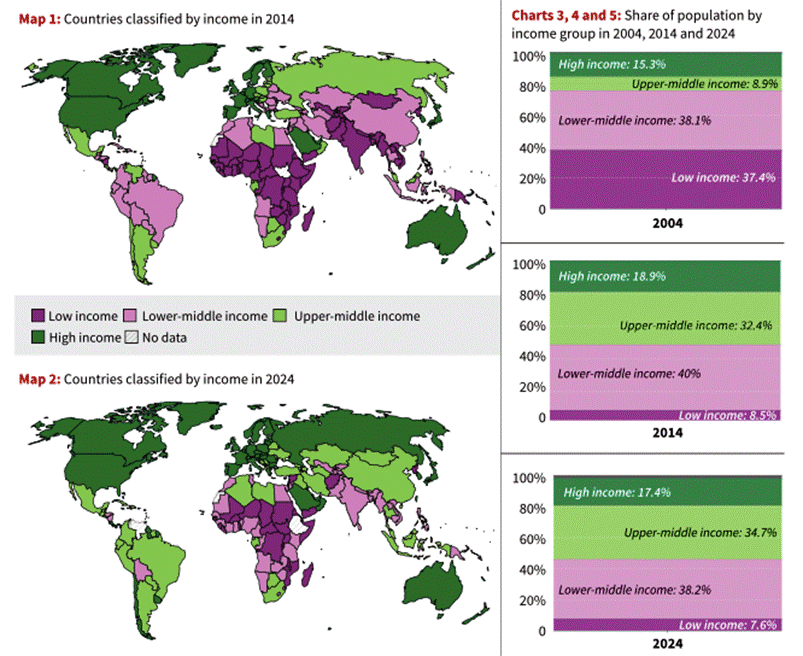Core Framework: World Bank Income Classification
- Purpose: Provides a standard method for comparing national incomes globally.
- Classification Groups:
- Low-income: ≤ $1,135
- Lower-middle income: $1,136–$4,495
- Upper-middle income: $4,496–$13,935
- High-income: ≥ $13,936
- Metric Used: Gross National Income (GNI) per capita
→ Includes domestic + income from abroad.
Relevance : GS 3(Growth and Development ) , GS 2(International Relations)

Methodology of Calculation
- Currency Conversion: GNI figures converted to USD using Atlas exchange rates.
- Annual Adjustment: Thresholds revised yearly based on global inflation (not relative economic performance).
- Absolute Nature: A country’s status is independent of others’ growth—purely based on whether it crosses a fixed threshold.
Origin and Evolution of the System
- Initiated: Late 1980s.
- Initial Purpose: To guide lending decisions—e.g., eligibility for concessional loans like IDA.
- Over time: Decoupled from operational decisions; now mainly used for economic comparison and monitoring progress.
Trends in Global Income Distribution (2004–2024)
- 2004:
- Low-income population: 37% of global total.
- Upper-middle income population: <10%.
- 2024:
- Low-income population: <10% — massive reduction in global poverty.
- Upper-middle income population: 35% — surge in economic advancement.
Countries That Slid Down
- Examples of Downward Mobility:
- Syria and Yemen fell from lower-middle to low-income in 2017 due to conflict and collapse of GDP.
- Triggers: War, currency depreciation, population revisions, prolonged recession.
Upward Mobility: General Trends
- Most countries show positive movement over 2–3 decades.
- Examples of Progress:
- India:
- 2004: Lower-middle income.
- 2024: On the cusp of upper-middle income; GNI per capita around $2,700–$2,900 (as per recent estimates).
- China:
- Crossed into upper-middle income around 2010.
- Now approaching high-income threshold.
- India:
Why These Classifications Matter for Policy
- Targeting Aid & Development Programs: Income groupings guide international aid, development priorities, and eligibility for concessional finance.
- Benchmark for National Policy: Helps assess progress under schemes like Atmanirbhar Bharat, Digital India, Skill India, etc.
- Investors & Analysts: Use income classification to assess country risk and market potential.
Limitations & Criticisms
- GNI per capita masks inequality: Rising averages can hide internal disparities.
- Currency fluctuations: Reclassification can occur due to exchange rate volatility, not real income changes.
- Absolute thresholds can delay recognition of structural poverty improvements or declines.
India’s Relevance in Global Context (2024)
- Status: Lower-middle income, close to threshold of $4,496.
- Policy Goals:
- Achieve upper-middle income status by early 2030s.
- Reduce dependency on external aid; shift to regional development leadership.
- Structural Enablers:
- Digital Public Infrastructure (DPI): UPI, CoWIN, ONDC.
- Manufacturing push: PLI schemes.
- Welfare inclusion: DBT, Jan Dhan-Aadhaar-Mobile (JAM trinity).



